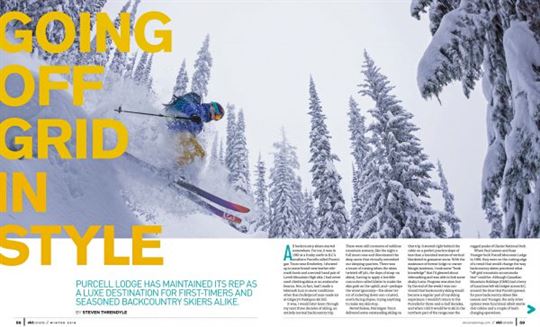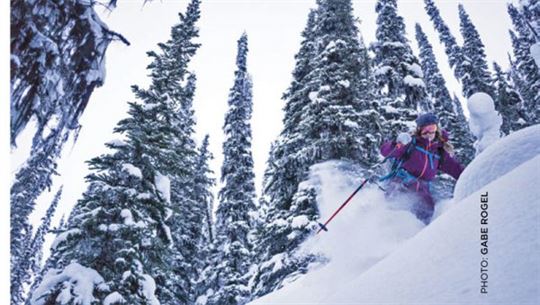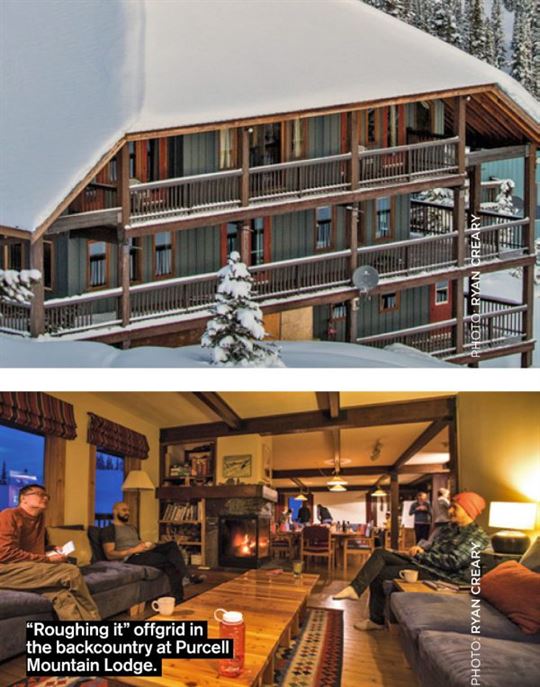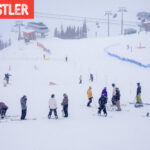Purcell Lodge has maintained its rep as a luxe destination for first-timers and seasoned backcountry skiers alike.

by STEVEN THRENDYLE in the Winter 2018 issue
All backcountry skiers started somewhere. For me, it was in 1982 at a funky outfit in B.C.’s southern Purcells called Ptarmigan Tours near Kimberley. I showed up in some brand-new leather telemark boots and a second-hand pair of Lovett Mountain High skis. I had never used climbing skins or an avalanche beacon. Nor, in fact, had I made a telemark turn in snow conditions other than bulletproof man-made ice at Calgary’s Paskapoo ski hill.
It was, I would later learn through my next three decades of skiing, an entirely normal backcountry trip. There were still moments of sublime mountain scenery, like the night a full moon rose and illuminated the deep snow that virtually entombed our sleeping quarters. There was a tonne of cursing when the skins twisted off (ah, the days of strap-on skins), having to apply a horrible concoction called klister to make the skis grab on the uphill, and—perhaps the worst ignominy—the sheer terror of rocketing down sun-crusted, south-facing slopes, trying anything to make my skis stop.
Nevertheless, Ptarmigan Tours delivered some outstanding skiing on that trip. It started right behind the cabin on a perfect practice slope of less than a hundred metres of vertical blanketed in gossamer snow. With the assistance of former lodge co-owner Margie Jamieson, I took some “book knowledge” that I’d gleaned about telemarking and was able to link some shaky turns. Progress was slow, but by the end of the week I was convinced that backcountry skiing would become a regular part of my skiing experience. I wouldn’t return to the Purcells for three-and-a-half decades, and when I did it would be to ski in the northern part of the range near the rugged peaks of Glacier National Park.
When Paul Leeson and Russ Younger built Purcell Mountain Lodge in 1989, they were on the cutting edge of a trend that would change the way backcountry skiers perceived what “off-grid mountain accommodation” could be. Although Canadian Mountain Holidays (CMH) had a bevy of luxurious heli-ski lodges across B.C. around the time that Purcell opened, for pure backcountry skiers like Leeson and Younger, the only other options were functional albeit sterile club cabins and a couple of hard-charging operations.
‘‘There will always be people curious or craving that kind of wilderness experience… ’’
I had wanted to ski at Purcell Mountain Lodge ever since Leeson and Younger had built it. At the time they seemed like evangelists for a new kind of touring operation catering to novice backcountry skiers, as dwell as traditional cross-country skiers and even snowshoers, since the gently tilted plateau surrounding the lodge had negligible avalanche danger. The lodge was gorgeous, the meals were fantastic, and you could even have—due to the wonders of a micro-hydro, run-of-the-river-style generating station—lights on after dark as well as a hot shower.
I finally got my chance to visit Purcell last season. The main group staying at the lodge was composed of a dozen or so fit, advanced-level backcountry skiers from Calgary whom, it turned out, I had several friendships in common. Though we lost a day of skiing at the start of the trip due to poor flying weather—a relative rarity at Purcell—the Calgary crew took off with Ken McDiarmid and Aaron Enns, guides who I noted were about as young as I was on my first Purcell trip back in 1982.
The boys made up for lost time, starting both days early and skiing till it was almost dark. On the second day, the group racked up more than 10,000 vertical feet of skiing—a more than respectable day in the mountains, and the snow was off the charts when it came to quality. Depending on weather and snow stability, we chose our runs to include a combination of wide-open, non-glaciated alpine bowls and perfectly spaced trees.

I spent my time skiing with lodge caretakers Hugh and Cheryl, a couple from Canmore, Alberta, who are part of what’s known as the “extended Purcell family.” Cabin fever even in paradise is possible apparently, so a rotating cast of caretakers fly in to ensure the lodge’s smooth operation. In return for room and board, they, like other volunteers, perform basic custodial duties and ski as much powder as they want.
In a short half-hour climb, we skinned up along the open ridge of Bald Mountain to the top of a perfectly sloped bowl known as Knee Knacker, named by Leeson and Younger back in those early telemark days. The snow quality proved outstanding, well over knee-deep powder on a fast, supportive base, which I thought would be a perfect introduction for neophyte backcountry skiers. The terrain made an easy transition into a steeper, yet welcoming glade. Among giant snow mushrooms perched precariously atop spindly spruce trees, the three of us whizzed through openings that magically appeared. Each turn was a fall-line fantasy, my skis dreamily steering wherever I wanted them to go. The beauty of Purcell lay in the realization that we could pretty much ski wherever we wanted—there were no crevasses to bridge or dangerous slopes to cross.

Each afternoon, we straggled into the lodge and collapsed into the large U-shaped couch beneath windows with panoramic views. Both the sauna and hot showers helped to revive energy before dinner, which is served around the rustic hand-hewn dining table where guests, guides and hosts talk skiing while enjoying the chef’s culinary creations.
In offering this kind of backcountry luxury three decades ago, Leeson and Younger were perhaps a bit ahead of their time. The lodge has undergone a couple of ownership changes over the years. In 2009 it was purchased by an MD-turned-entrepreneur with the hopeful-sounding name of Sunny Sun, and it remains the kind of place you’d want to visit to celebrate a special occasion. Although backcountry skiers are the main clientele in the winter, snowshoers are more than welcome.
Purcell Mountain Lodge, with its resort-style accommodations, seeks to open the winter backcountry to virtually everyone, including keen neophytes with a bit of a taste for adventure. There will always be people curious or craving that kind of wilderness experience—just don’t wait three decades to visit like I did.



